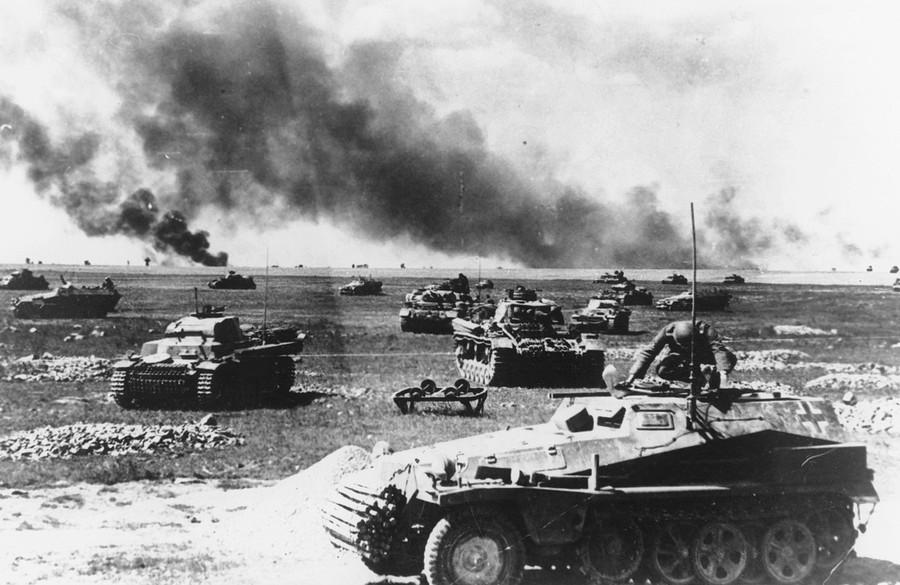German deception; Operation Kremlin
Author guest post from Norman Ridley.

By the end of October 1941, a combination of factors had resulted in the first major Wehrmacht reversal of the Second World War. Faulty intelligence, poor logistical planning, atrocious weather and the unexpected tenacity of the Red Army soldiers had halted the Germans all along the entire front and especially at the gates of Moscow. Losses of men and material could not be replaced in full meaning that any 1942 offensive would be conducted along a single axis as opposed to three in the original attack. There were only 2,847,000 German troops in the east and they were plagued by shortages of tanks, motor vehicles, horses, ammunition and fuel. Renewing the offensive against Moscow would have made strategic sense given that there were forces in place to execute it and the morale-boosting effect of taking the city would be considerable both in the field and back home but Hitler decided that an attack against the most heavily defended sector of the whole eastern front would be too costly and, instead, initiated Fall Blau (Operation Blue). This was a plan to secure the Caucasus oilfields and, as a secondary objective, occupy the city of Stalingrad thus controlling armament supply centres and economic resources of the Volga region, which would, in the longer term, be more beneficial to the whole German war effort. Intelligence reported that the Caucasus supplied more than 90 per cent of all Soviet oil requirements.
It was important, however, to convince the Soviets that Moscow would indeed be the target of the 1942 summer offensive and so a strategy of deception was begun under the code name of Fall Kreml (Operation Kremlin). On 12 February 1942, OKW chief Field Marshal Wilhelm Keitel, issued a directive entitled Richtlinien für die Feindtäuschung (Guidelines for Enemy Deception). German counterintelligence agents were given the job of convincing the Soviets that Moscow and the industrial areas of the middle Volga region would be the primary targets of the renewed German offensive. Members of the recently formed Russkaia Natsional’naia Narodnaia Armiia (Russian Nationalist People’s Army – RNNA), made up of former Red Army PoWs, were trained as spies and saboteurs and transferred to the Soviet rear. Operation Kreml was kept secret even from Germany’s other Axis partners.
Importantly, preparations for Operation Blue would be made well to the German rear and would be largely hidden from Soviet intelligence but could not remain secret forever and so, in May, efforts were made to convince the Soviets that the German Army Group South had inherent weaknesses. German units were withdrawn from that front, ostensibly for transfer to Army Group North and they were replaced by those of satellite armies. Army Group North, meanwhile, intensified reconnaissance on the Moscow front and spread misinformation through increased radio traffic, which they knew would be picked up by the Soviets. At home, military journals and the German press reported on the vital importance of Moscow as the focal point of Soviet resistance and suggested that the city’s capture was Germany’s priority. Stalin and Stavka (the Soviet High Command) took little persuasion that Moscow was the true target. It made sound strategic sense to them and was what they would have done under the same circumstances. It would take a lot for them to change their minds.
On 29 May, the commander-in-chief of Army Group Centre, Field Marshal Günther von Kluge, finally signed the order that supposedly made Moscow the target of the German summer offensive and copies of the order were deliberately allowed to fall into Soviet hands. The order stated that the armies were to be ready to begin their attack no later than the end of June.
Soon afterwards the intelligence department of Army Group Centre reported a concentration of Soviet armour and a strengthening of defences near Belëv (Belyov) apparently in ‘nervous’ preparation for a German attack. It was understandable that the Soviets expected a renewal of the German offensive against Moscow and they prioritised reinforcement of the Bolkhov-Belëv and Orël-Mtsensk sectors. The British, however, cast doubt on the Soviet strategy by passing on Enigma intelligence showing that the German VIII Fliegerkorps was being transferred from the central sector to the Crimea, indicating that a German offensive was imminent there. Again, Stalin was sceptical and refused to accord sufficient importance to British intelligence reports. The Soviets also misinterpreted the movement of German Panzer units from Bryansk to Orël as part of the build up to a Moscow offensive when, in fact, these units were in transit to Army Group South.
On 5 June 1942, to the north of Kirov, the German 4th Army issued an order detailing plans for an attack in the Sukhinichi salient and another north of Bolkhov towards the Oka river. A 1:300,000 scale map together with a detailed list of requests for additional reserves was issued. It called for air support concentrated in the sector of LVI Panzer Corps. XXXXVII Panzer Corps would try to take the important town of Tula. A particularly strong contingent was concentrated along a short front of the Sukhinichi salient. Increased numbers of agents were sent across the lines and the fact that most did not return indicated that Soviet intelligence was clearly aware of intensification of activity. On 13 June, the chief intelligence officer of Army Group Centre reported his opinion that the deception had been a complete success. The Soviets had fallen into a defensive posture and had commenced attacks in the Bolkhov-Belëv sector and other places along the front to impede German preparations and gain some intelligence about German dispositions. The object was to allow various pieces of the puzzle to fall into Soviet hands and let them put the jigsaw together themselves.
By now, the armies involved were working hard together to try to give the impression that they were preparing for a genuine operation but still, only the chiefs of staff of the headquarters in question knew that the whole operation was merely an elaborate ruse. Then with only days to go before Operation Blue was to start, the chief of operations of XXIII Panzer Division, Major Joachim Reichel, crash-landed behind Soviet lines while on a reconnaissance mission. Against all of Hitler’s strict protocols for the operation, he had been carrying orders, maps and details of deployments for the first stage of Operation Blue that the Soviet’s recovered from the wreckage. When this was reported to Stalin, he interpreted it as yet more misinformation to disguise the German attack against Moscow.
The German Army Group South began Operation Blue on 28 June by smashing through the almost 2 million Soviet Red Army forces and advancing almost 50 kilometres on the first day. The Soviets had twenty-eight armies between Leningrad and Tula, but only eighteen in the southern sector between Tula and the Caucasus. The Soviet collapse allowed the Germans to capture the western part of Voronezh on 6 July and wheel south towards Stalingrad. At the same time, the Germans finally started winding down Operation Kremlin, but the Soviets were still deceived and they continued to attempt to make a breakthroughs along the Orël-Briansk line. The Chief of Staff of Army Group Centre, Major General Otto Wöhler, was sure that the Soviets had transferred only very few units south and had clearly strengthened their defences before Moscow. Only weeks after the major Soviet defeat at Kharkiv in May, Stalin and Stavka were still wedded to the view that Moscow was the real target despite Soviet intelligence identifying the large concentration of German forces and their preparations for an offensive on the southern strategic axis. Stalin and Molotov also continued to ignore British intelligence pointing to the Caucasus still suspected that, at some point, Britain and the United States would strike a deal with Germany to cease hostilities, leaving the German and Soviet armies to destroy each other on the Steppes. The Soviet Lieutenant General Ivan Bagramian, who was the Chief of Staff of South-Western Direction at the time, later refused to admit that the destruction of his forces had anything to do with Operation Kremlin, but it is clear that he was in denial.

Order your copy here.

